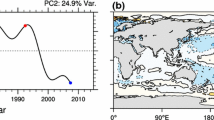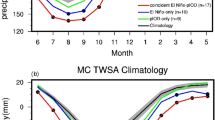Abstract
We introduce a simple but effective means of removing ENSO-related variations from the Indian Ocean Dipole (IOD) in order to better evaluate the ENSO-independent IOD contribution to Australian climate—specifically here interannual variations in Australian region tropical cyclogensis (TCG) counts. The ENSO time contribution is removed from the Indian Ocean Dipole Mode index (DMI) by first calculating the lagged regression of the DMI on the sea surface temperature anomaly (SSTA) index NINO3.4 to maximum lags of 8 months, and then removing this ENSO portion. The new ENSO-independent time series, DMINOENSO, correlates strongly with the original DMI at r = 0.87 (significant at >99% level). Despite the strength of the correlation between these series, the IOD events classified based on DMINOENSO provide important differences from previously identified IOD events, which are more closely aligned with ENSO phases. IOD event composite maps of SSTAs regressed on DMINOENSO reveal a much greater ENSO-independence than the original DMI-related SSTA pattern. This approach is used to explore relationships between Australian region TCG and IOD from 1968 to 2007. While we show that both the DMI and DMINOENSO have significant hindcast skill (on the 95% level) when used as predictors in a multiple linear regression model for Australian region annual TCG counts, the IOD does not add any significant hindcast skill over an ENSO-only predictor model, based on NINO4. Correlations between the time series of annual TCG count observations and ENSO + IOD model cross-validated hindcasts achieve r = 0.68 (significant at the 99% level).






Similar content being viewed by others
References
Allan RJ, Chambers D, Dosdrowsky W, Hendon HH, Latif M, Nicholls N, Smith I, Stone RC, Tourre Y (2001) Is there an Indian Ocean Dipole, and is it independent of the El Niño-Southern Oscillation? CLIVAR Exch 6:18–22
Ashok K, Guan Z, Yamagata T (2003) Influence of the Indian Ocean Dipole on the Australian winter rainfall. Geophys Res Lett 30:1821. doi:10.1029/2003GL017926
Basher RE, Zheng X (1995) Tropical cyclones in the southwest Pacific: spatial patterns and relationships to Southern Oscillation and sea surface temperature. J Clim 8:1249–1260
Cai W, Whetton PH, Pittock AB (2001) Fluctuations of the relationship between ENSO and northeast Australian rainfall. Clim Dyn 17:421–432
Davis RE (1976) Predictability of sea surface temperatures and sea level pressure anomalies over the North Pacific Ocean. J Phys Oceanogr 6:249–266
Elsner JB, Jagger TH (2006) Prediction models for annual US hurricane counts. J Clim 19:2935–2952
Evans JL, Allan RL (1992) El Nino/Southern Oscillation modification to the structure of the monsoon and tropical cyclone activity in the Australasian region. Int J Climatol 12:611–623
Hendon HH, Hudson D, Wang G, Alves O (2009) Dynamical forecasts of inter-El Nino variations of tropical SST and Australian springtime rainfall. Mon Wea Rev 137:3796–3810
Knapp KR, Kruk MC, Levinson DH, Diamond HJ, Neumann CJ (2010) The international best track archive for climate stewardship (IBTrACS). Bull Am Meteorol Soc 91:363–376
Kuleshov Y, de Hoedt G (2003) Tropical cyclone activity in the Southern Hemisphere. Bull Austral Meteorol Oceanogr Soc 16:135–137
Kuleshov Y, Qi L, Fawcett R, Jones D (2008) On tropical cyclone activity in the Southern Hemisphere: trends and the ENSO connection. Geophys Res Lett 35:L14S08. doi:10.1029/2007GL032983
Kuleshov Y, Chane Ming F, Qi L, Chouaibou I, Hoareaux C, Roux F (2009) Tropical cyclone genesis in the southern hemisphere and its relationship with the ENSO. Ann Geophys 27:2523–2538
Liu KS, Chan JC (2010) Interannual variation of Southern Hemisphere tropical cyclone activity and seasonal forecast of tropical cyclone number in the Australian region. Int J Climatol. doi:10.1002/joc.2259
Meyers G, McIntosh PC, Pigot L, Pook M (2007) The years of El Niño, La Niña, and interactions with the tropical Indian Ocean. J Clim 20:2872–2880
Nicholls N (1984) The southern oscillation, sea-surface temperature, and interannual fluctuations in Australian tropical cyclone activity. J Climatol 4:661–1149
Philander SGH (1990) El Niño, La Niña and the Southern Oscillation. Academic Press, San Diego, p 289
Ramsay HA, Leslie LM, Lamb PJ, Richman MB, Leplastrier M (2008) Interannual variability of tropical cyclones in the Australian region: role of large-scale environment. J Clim 21:1083–1103
Rayner NA, Parker DE, Horton EB, Folland CK, Alexander LV, Rowell DP, Kent EC, Kaplan A (2003) Global analyses of sea surface temperature, sea ice, and night marine air temperature since the late nineteenth century. J Geophys Res 108(D14):4407. doi:10.1029/2002JD002670
Risbey JS, Pook MJ, McIntosh PC, Wheeler MC, Hendon HH (2009) On the remote drivers of rainfall variations in Australia. Mon Wea Rev 137:3233–3253
Saji NH, Yamagata T (2003) Structure of SST and surface wind variability during Indian Ocean Dipole mode years: COADS observations. J Clim 16:2735–2751
Saji NH, Goswami BN, Vinayachandran PN, Yamagata T (1999) A dipole mode in the tropical Indian Ocean. Nature 401:360–363
Saji NH, Ambrizzi T, Ferraz SET (2005) Indian Ocean Dipole mode events and austral surface air temperature anomalies. Dyn Atmos Oceans 39:87–101
Solow A, Nicholls N (1990) The relationship between Southern Oscillation and tropical cyclone frequency in the Australian region. J Clim 3:1097–1101
Stone M (1974) Cross-validatory choice and assessment of statistical predictions. J Royal Stat Soc 36(2):111–147
Ummenhofer CC, England MH, McIntosh PC, Meyers GA, Pook MJ, Risbey JS, Sen Gupta A, Taschetto AS (2009) What causes Southeast Australia’s worst droughts? Geophys Res Lett 36:L04706. doi:10.1029/2008GL036801
Webster PJ, Moor AM, Loschnigg JP, Leben RR (1999) Coupled ocean–atmosphere dynamics in the Indian Ocean during 1997–1998. Nature 401:356–360
Acknowledgments
A. Werner was supported by MQRES and PGRF Scholarships from Macquarie University, Australia. AW also thanks the School of Geography and Environmental Studies at the University of Tasmania for providing computing resources and office space during her visits to the University of Tasmania. Finally, we wish to thank Dr. Peter C. McIntosh from the Centre for Australian Weather and Climate Research for his constructive comments on this work.
Author information
Authors and Affiliations
Corresponding author
Rights and permissions
About this article
Cite this article
Werner, A., Maharaj, A.M. & Holbrook, N.J. A new method for extracting the ENSO-independent Indian Ocean Dipole: application to Australian region tropical cyclone counts. Clim Dyn 38, 2503–2511 (2012). https://doi.org/10.1007/s00382-011-1133-y
Received:
Accepted:
Published:
Issue Date:
DOI: https://doi.org/10.1007/s00382-011-1133-y




